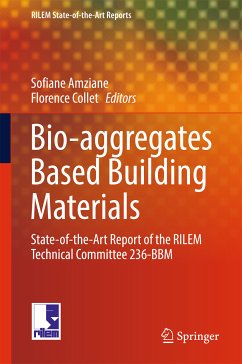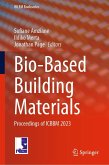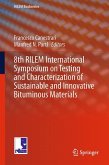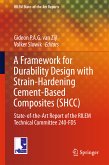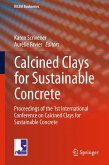Bio-aggregates Based Building Materials (eBook, PDF)
State-of-the-Art Report of the RILEM Technical Committee 236-BBM
Redaktion: Amziane, Sofiane; Collet, Florence
128,95 €
128,95 €
inkl. MwSt.
Sofort per Download lieferbar

64 °P sammeln
128,95 €
Als Download kaufen

128,95 €
inkl. MwSt.
Sofort per Download lieferbar

64 °P sammeln
Jetzt verschenken
Alle Infos zum eBook verschenken
128,95 €
inkl. MwSt.
Sofort per Download lieferbar
Alle Infos zum eBook verschenken

64 °P sammeln
Bio-aggregates Based Building Materials (eBook, PDF)
State-of-the-Art Report of the RILEM Technical Committee 236-BBM
Redaktion: Amziane, Sofiane; Collet, Florence
- Format: PDF
- Merkliste
- Auf die Merkliste
- Bewerten Bewerten
- Teilen
- Produkt teilen
- Produkterinnerung
- Produkterinnerung

Bitte loggen Sie sich zunächst in Ihr Kundenkonto ein oder registrieren Sie sich bei
bücher.de, um das eBook-Abo tolino select nutzen zu können.
Hier können Sie sich einloggen
Hier können Sie sich einloggen
Sie sind bereits eingeloggt. Klicken Sie auf 2. tolino select Abo, um fortzufahren.

Bitte loggen Sie sich zunächst in Ihr Kundenkonto ein oder registrieren Sie sich bei bücher.de, um das eBook-Abo tolino select nutzen zu können.
The work of the RILEM Technical Committee (TC -236 BBM) was dedicated to the study of construction materials made from plant particles. It considered the question whether building materials containing as main raw material recyclable and easily available plant particles are renewable.
>
- Geräte: PC
- ohne Kopierschutz
- eBook Hilfe
- Größe: 8.24MB
Andere Kunden interessierten sich auch für
![Bio-Based Building Materials (eBook, PDF) Bio-Based Building Materials (eBook, PDF)]() Bio-Based Building Materials (eBook, PDF)232,95 €
Bio-Based Building Materials (eBook, PDF)232,95 €![8th RILEM International Symposium on Testing and Characterization of Sustainable and Innovative Bituminous Materials (eBook, PDF) 8th RILEM International Symposium on Testing and Characterization of Sustainable and Innovative Bituminous Materials (eBook, PDF)]() 8th RILEM International Symposium on Testing and Characterization of Sustainable and Innovative Bituminous Materials (eBook, PDF)160,95 €
8th RILEM International Symposium on Testing and Characterization of Sustainable and Innovative Bituminous Materials (eBook, PDF)160,95 €![A Framework for Durability Design with Strain-Hardening Cement-Based Composites (SHCC) (eBook, PDF) A Framework for Durability Design with Strain-Hardening Cement-Based Composites (SHCC) (eBook, PDF)]() A Framework for Durability Design with Strain-Hardening Cement-Based Composites (SHCC) (eBook, PDF)88,95 €
A Framework for Durability Design with Strain-Hardening Cement-Based Composites (SHCC) (eBook, PDF)88,95 €![RILEM Technical Committee 195-DTD Recommendation for Test Methods for AD and TD of Early Age Concrete (eBook, PDF) RILEM Technical Committee 195-DTD Recommendation for Test Methods for AD and TD of Early Age Concrete (eBook, PDF)]() Øyvind BjøntegaardRILEM Technical Committee 195-DTD Recommendation for Test Methods for AD and TD of Early Age Concrete (eBook, PDF)72,95 €
Øyvind BjøntegaardRILEM Technical Committee 195-DTD Recommendation for Test Methods for AD and TD of Early Age Concrete (eBook, PDF)72,95 €![8th RILEM International Conference on Mechanisms of Cracking and Debonding in Pavements (eBook, PDF) 8th RILEM International Conference on Mechanisms of Cracking and Debonding in Pavements (eBook, PDF)]() 8th RILEM International Conference on Mechanisms of Cracking and Debonding in Pavements (eBook, PDF)160,95 €
8th RILEM International Conference on Mechanisms of Cracking and Debonding in Pavements (eBook, PDF)160,95 €![Calcined Clays for Sustainable Concrete (eBook, PDF) Calcined Clays for Sustainable Concrete (eBook, PDF)]() Calcined Clays for Sustainable Concrete (eBook, PDF)175,95 €
Calcined Clays for Sustainable Concrete (eBook, PDF)175,95 €![Bio-Based Building Materials - Proceedings of ICBBM 2025 (eBook, PDF) Bio-Based Building Materials - Proceedings of ICBBM 2025 (eBook, PDF)]() Bio-Based Building Materials - Proceedings of ICBBM 2025 (eBook, PDF)216,95 €
Bio-Based Building Materials - Proceedings of ICBBM 2025 (eBook, PDF)216,95 €-
-
-
The work of the RILEM Technical Committee (TC -236 BBM) was dedicated to the study of construction materials made from plant particles. It considered the question whether building materials containing as main raw material recyclable and easily available plant particles are renewable.
>
>
Dieser Download kann aus rechtlichen Gründen nur mit Rechnungsadresse in A, B, BG, CY, CZ, D, DK, EW, E, FIN, F, GR, HR, H, IRL, I, LT, L, LR, M, NL, PL, P, R, S, SLO, SK ausgeliefert werden.
Produktdetails
- Produktdetails
- Verlag: Springer Netherlands
- Seitenzahl: 263
- Erscheinungstermin: 4. Februar 2017
- Englisch
- ISBN-13: 9789402410310
- Artikelnr.: 53036190
- Verlag: Springer Netherlands
- Seitenzahl: 263
- Erscheinungstermin: 4. Februar 2017
- Englisch
- ISBN-13: 9789402410310
- Artikelnr.: 53036190
- Herstellerkennzeichnung Die Herstellerinformationen sind derzeit nicht verfügbar.
Chapter 1. Chemical composition of bioaggregates and their interactions with mineral binders.- 1.0 Introduction.- 1.1 Composition of hemp stem.- 1.2 Processing of hemp stem and microstructure of hemp shiv.- 1.3 Cell wall components.- 1.4 Chemical composition of bioaggregates.- 1.5 Surface characterization of bioaggregates - adhesion between lignocellulosic aggregates and a mineral binder.- 1.6 Chemical interactions between bioaggregates and mineral binders.- 1.7 Conclusion.- References.- Chapter 2. Porosity, pore size distribution, micro-structure.- 2.0 Introduction.- 2.1 Techniques used to measure porosity.- 2.2 Conclusion.- References.- Chapter 3. Water absorption of plant aggregate.- 3.0 Introduction.- 3.1 Wetting of porous, heterogeneous surfaces.- 3.2 Transfer phenomena in a porous medium.- 3.3 Analogy with adhesion of mortars to a porous support.- 3.4 Overview of the processes of binder/wood adhesion.- 3.5 Conclusion.- References.- Chapter 4. Particle Size Distribution.- 4.0 Introduction.- 4.1 General characteristics of shiv particles.- 4.2 Sieving methods .- 4.3 Image-processing methods.- 4.4 Image-analysis.- 4.5 Characterization of the PSD.- 4.6 Conclusions.- References.- Chapter 5. Bulk density and compressibility.- 5.0 Introduction.- 5.1 Density and porosity, case of hemp shiv.- 5.2 Bulk compressibility.- 5.3 Conclusions and perspectives.- References.- Chapter 6. Hygric and thermal properties of bio-aggregate based building materials.- 6.0 Introduction.- 6.1 Hygric properties.- 6.2 Thermal properties.- 6.3 Concluding remarks on hygrothermal behavior of bio-aggregate based building materials.- References.- Chapter 7. Bio-aggregate based building materials exposed to fire7.1 Introduction.- 7.2 Fire reaction.- 7.3 Fire resistance.- 7.4 Real scale fire tests.- 7.5 Other quaint matter fire test.- References.- Chapter 8. Durability of bio-based concretes.- 8.0 Introduction.- 8.1 Accelerated aging protocols for bio-based construction materials.-8.2 Aging of bio-based concretes.- 8.3 Aging of natural fibres-cement composites.- 8.4 Concluding remarks.- References.- Chapter 9. Effect of testing variables (method of production).- 9.0 Introduction.- 9.1 Materials and methods.- 9.2 Results.- 9.3 Conclusion.- Acknowledgments.- References.- APPENDIX : Technical Commitee Report - Rilem TC 236 BBM - Bio based Building Materials - Round Robin test for hemp shiv Characterisation.- Round Robin Test For Hemp shiv Characterisation.- Part 1 : Evaluation Of Initial Water Content And Water Absorption.- 1 Introduction.- 2 Material.- 52%.- 18%.- 2.1 Microscopical description.- 3 Initial Water Content.- 3.1 Methods.- 3.2 Results.- 3.3 Concluding remarks on initial water content.- 4 Water Absorption.- 4.1 Description of the experimental methods.- 4.2 Results.- 4.3 Concluding remarks.- Summary of Findings.- Round Robin Test For Hemp shiv Characterisation.- Part 2: Bulk Density And Particle Size Distribution.- 5 Introduction.- 6 Material.- 52%.- 18%.- 7 Bulk Density.- 7.1 Methods.- 7.2 Results.- 7.3 Concluding remarks on bulk density.- 8 Particle Size Distribution.- 8.1 Sieving method.- 8.2 Image processing.- 8.3 Comparison between sieving and image analysis results.- 8.4 Concluding remarks on Particle Size Distribution.- Summary Of Findings.- Acknowledgements.- Round Robin Test For Hemp shiv Characterisation.- Part 3 : Thermal Conductivity.- 9 Introduction.- 10 Material.- 52%.- 18%.- 11 Thermal Conductivity.- 11.1 Experimental methods.- 11.2 Results.- 11.3 Concluding remarks.- Summary Of Findings.- Acknowledgements.
Chapter 1. Chemical composition of bioaggregates and their interactions with mineral binders.- 1.0 Introduction.- 1.1 Composition of hemp stem.- 1.2 Processing of hemp stem and microstructure of hemp shiv.- 1.3 Cell wall components.- 1.4 Chemical composition of bioaggregates.- 1.5 Surface characterization of bioaggregates - adhesion between lignocellulosic aggregates and a mineral binder.- 1.6 Chemical interactions between bioaggregates and mineral binders.- 1.7 Conclusion.- References.- Chapter 2. Porosity, pore size distribution, micro-structure.- 2.0 Introduction.- 2.1 Techniques used to measure porosity.- 2.2 Conclusion.- References.- Chapter 3. Water absorption of plant aggregate.- 3.0 Introduction.- 3.1 Wetting of porous, heterogeneous surfaces.- 3.2 Transfer phenomena in a porous medium.- 3.3 Analogy with adhesion of mortars to a porous support.- 3.4 Overview of the processes of binder/wood adhesion.- 3.5 Conclusion.- References.- Chapter 4. Particle Size Distribution.- 4.0 Introduction.- 4.1 General characteristics of shiv particles.- 4.2 Sieving methods .- 4.3 Image-processing methods.- 4.4 Image-analysis.- 4.5 Characterization of the PSD.- 4.6 Conclusions.- References.- Chapter 5. Bulk density and compressibility.- 5.0 Introduction.- 5.1 Density and porosity, case of hemp shiv.- 5.2 Bulk compressibility.- 5.3 Conclusions and perspectives.- References.- Chapter 6. Hygric and thermal properties of bio-aggregate based building materials.- 6.0 Introduction.- 6.1 Hygric properties.- 6.2 Thermal properties.- 6.3 Concluding remarks on hygrothermal behavior of bio-aggregate based building materials.- References.- Chapter 7. Bio-aggregate based building materials exposed to fire7.1 Introduction.- 7.2 Fire reaction.- 7.3 Fire resistance.- 7.4 Real scale fire tests.- 7.5 Other quaint matter fire test.- References.- Chapter 8. Durability of bio-based concretes.- 8.0 Introduction.- 8.1 Accelerated aging protocols for bio-based construction materials.-8.2 Aging of bio-based concretes.- 8.3 Aging of natural fibres-cement composites.- 8.4 Concluding remarks.- References.- Chapter 9. Effect of testing variables (method of production).- 9.0 Introduction.- 9.1 Materials and methods.- 9.2 Results.- 9.3 Conclusion.- Acknowledgments.- References.- APPENDIX : Technical Commitee Report - Rilem TC 236 BBM - Bio based Building Materials - Round Robin test for hemp shiv Characterisation.- Round Robin Test For Hemp shiv Characterisation.- Part 1 : Evaluation Of Initial Water Content And Water Absorption.- 1 Introduction.- 2 Material.- 52%.- 18%.- 2.1 Microscopical description.- 3 Initial Water Content.- 3.1 Methods.- 3.2 Results.- 3.3 Concluding remarks on initial water content.- 4 Water Absorption.- 4.1 Description of the experimental methods.- 4.2 Results.- 4.3 Concluding remarks.- Summary of Findings.- Round Robin Test For Hemp shiv Characterisation.- Part 2: Bulk Density And Particle Size Distribution.- 5 Introduction.- 6 Material.- 52%.- 18%.- 7 Bulk Density.- 7.1 Methods.- 7.2 Results.- 7.3 Concluding remarks on bulk density.- 8 Particle Size Distribution.- 8.1 Sieving method.- 8.2 Image processing.- 8.3 Comparison between sieving and image analysis results.- 8.4 Concluding remarks on Particle Size Distribution.- Summary Of Findings.- Acknowledgements.- Round Robin Test For Hemp shiv Characterisation.- Part 3 : Thermal Conductivity.- 9 Introduction.- 10 Material.- 52%.- 18%.- 11 Thermal Conductivity.- 11.1 Experimental methods.- 11.2 Results.- 11.3 Concluding remarks.- Summary Of Findings.- Acknowledgements.
